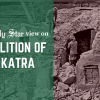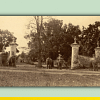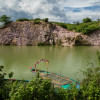Shakrain: Kites and tastes of Old Dhaka

Every year, on the evening of 14 January, a walk around the streets of Old Dhaka would reveal an unfamiliar vibe in the familiar streets as Dhakaites prepare to celebrate Shakrain. Along with the lively chatter on the streets, rooftops become active, and the sky turns into a battleground for aerial kite fights.
Marking the end of Poush on the Bengali calendar, "Poush Sankranti", as it is known, is not just about outward celebrations. As kites soar high in the air, households remain busy preparing traditional Bengali pithas, rice cakes, and other treats that bring families and neighbours together.
Narinda and the tradition of Shakrain
Among Dhaka's oldest neighbourhoods, Narinda is noted for landmark structures like the Binat Bibi Mosque, established in 1452 C.E., the famed Baldha Garden, and the historic Christian cemetery. As you stroll around the neighbourhood, you will come across eateries like Beauty Lassi and Jhunur Polao, which add a gastronomic layer to the fabric of this famed locality.
Syed Jahangir, 74, has lived here for the better part of his life and can trace his ancestral roots in Narinda's Lalmohan Saha Street. For generations, his family has witnessed the glory days of Old Dhaka, its fall from prominence, and a recent but renewed interest in its history and culture.

"Shakrain is now observed by the entire community of Old Dhaka," he said. "To this day, Narinda remains one of the hotspots of the Shakrain festival."
Strolling through these streets, one feels a sense of unity as residents prepare for the celebration. It seems that while the rituals of the occasion have not been fully adopted, the festivities have been widely accepted and practised.
Early memories and festive foods
Syed Jahangir gave us a snippet of his earliest recollections of the festivities, which would always begin at dawn.
"Soon after morning prayers, families would gather around a spread of delectable pithas prepared by the women of the household," he said.

For over forty years, Nasima Jahan has held the mantle of the Jahangir family. She shared that the fragrant rice cakes somewhat symbolised the warmth of the tradition.
"The preparations for the elaborate breakfast would begin days before as the finest rice grains from the harvest were sourced, husked, and chipped or powdered for making pithas. The best quality jaggery and date palm juice were also used as sweeteners," Jahan shared.
This was also a chance for the seniors to once again show off their culinary skills to their sons-in-law, as they were the special guests of this yearly tradition.
"By 8 AM everyone would have been on the rooftops with their kites, ready to engage in aerial duels," mentioned Syed Jahangir. He added, "Popular songs from the silver screen would play in the background as an encouragement for the 'fighters.'"
The whiff of mustard oil from the kitchen signalled that lunch was ready. Both Syed Jahangir and his wife, Nasima Jahan, recalled that back in the day, and even today, Shakrain's lunch was incomplete at their household without beef tehari.
"In my family, duck meat was served along with the occasional game father would bring from his hunting adventures," Nasima Jahan added. "This was eaten with warm, soft chitoi pithas."
As the day progressed, an air of excitement would build along the lanes, with the kite-flying matches reaching their heights. There were standard rules for the game with score sheets, and by sunset, the winners would be decided.
"Traditionally, the Shakrain festival would have been wrapped up by sundown. An evening snack of pithas and fritters ended the evening on a high note," said Nasima Jahan. As the event drew to a close each year, families and friends left the rooftops not just with memories of kite fights but with the lingering taste of Dhaka's beloved dishes.
Of evolving flavours
The food of Shakrain and the diverse flavours still keep the spirit of the festival alive. Syed Murtaja Jahangir, an investment professional, recalls celebrating Shakrain with his parent since the early 1990s.
"While the festival once revolved around local favourites like pithas and tehari, the modern-day versions include tandoori and barbecue — dishes that have found their way into Old Dhaka's rooftop scene alongside the kites.
"Walking past various rooftops now, the smell of grilled skewers is often stronger than that of the traditional rice cakes. Honestly, the younger generations look forward to grilled skewers more than the pithas," noting the changes in taste and tradition.

Murtaja has had the opportunity of witnessing Shakrain being celebrated in its more orthodox forms along with the 21st-century additions.
"By the early 2000s, as far as the celebrations were concerned, kite flying was now accompanied by music loaned from Bollywood, soon to be replaced by Western chart-toppers," he said.
Now things have become quite 'chaotic' with DJs being hired and fire-spinners in action. This change is expected but perhaps not accepted by a majority of the people.
For senior citizens like Syed Jahangir and Nasima Jahan, this is not the way they want Shakrain to be celebrated. Even Murtaja, their son, has reservations.
"Traditionally, the festivity would have been wrapped up by sunset. An evening snack of pithas and fritters drew the curtain of Shakrain for a whole year. Yet, as you pass by, some rooftops now remain alight with dancing and music well into the night."
Shakrain in Narinda beautifully captures the spirit of a community bound by tradition and good food. While evolving tastes and modern additions reshape its celebrations, the festival remains a cherished marker of Dhaka's cultural heritage. It has united generations in the past and continues to do so today.
Photo: Orchid Chakma
Food styling: Raffat Binte Rashid
This article was written as part of a collaboration between Star Lifestyle and Goethe-Institut Bangladesh.

 For all latest news, follow The Daily Star's Google News channel.
For all latest news, follow The Daily Star's Google News channel. 








Comments